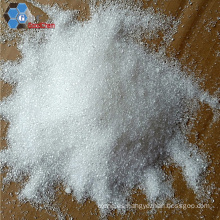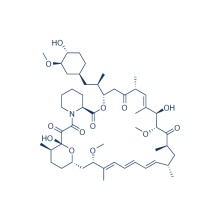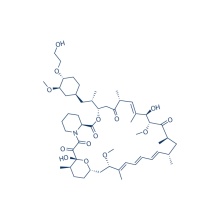.cp_wz tabla {borde superior: 1px sólido #ccc; borde izquierdo: 1px sólido #ccc; } .cp_wz table td {borde derecho: 1px sólido #ccc; borde inferior: 1px sólido #ccc; padding: 5px 0px 0px 5px;} .cp_wz table th {border-right: 1px solid #ccc; border-bottom: 1px solid #ccc; relleno: 5px 0px 0px 5px;} \ n Peso molecular: 528.61 WYE-687 es un inhibidor selectivo y competitivo de ATP de mTOR con IC50 de 7 nM; bloquea mTORC1 / pS6K (T389) y mTORC2 / P-AKT (S473) pero no se observó ningún efecto en P-AKT (T308). La selectividad para mTOR es mayor que PI3Kα (> 100 veces) y PI3Kγ (> 500 veces). El ensayo de quinasa de inmunocomplejos muestra que el sustrato His6-AKT específico de mTORC2 o el sustrato de mTORC1 His6-S6K es inhibido de forma dependiente de la dosis por WYE-687. WYE-687 inhibe globalmente la señalización de mTOR y la función AKT en modelos celulares de forma dependiente de la dosis. WYE-678 inhibe profundamente la síntesis de proteínas global y dependiente del casquete en MDA361, células de cáncer de mama humano. WYE-687 muestra efectos antiproliferativos en varias líneas de células cancerosas que implican la detención del ciclo celular G1 y la apoptosis selectiva. WYE-687 regula a la baja los factores angiogénicos, VEGF y HIF-1α, en células U87MG, MDA361 y LNCap.
orte
|
DELFIA Format of Purified FLAG-TOR
|
The routine assays with purified FLAG-TOR (FL and 3.5) are performed in 96-well plates as follows. Enzymes are first diluted in kinase assay buffer (10 mM Hepes (pH 7.4), 50 mM NaCl, 50 mM β-glycerophosphate, 10 mM MnCl2, 0.5 mM DTT, 0.25 lM microcystin LR, and 100 lg/mL BSA). To each well, 12 μL of the diluted enzyme is mixed briefly with 0.5 μL test inhibitor or control vehicle dimethyl sulfoxide (DMSO). The kinase reaction is initiated by adding 12.5 μL kinase assay buffer containing ATP and His6-S6K to give a final reaction volume of 25 μL containing 800 ng/mL FLAG-TOR, 100 μM ATP, and 1.25 μM His6-S6K. The reaction plate is incubated for 2 hours (linear at 1-6 hour) at room temperature with gentle shaking and then terminated by adding 25 μL Stop buffer (20 mM Hepes (pH 7.4), 20 mM EDTA, and 20 mM EGTA).
The DELFIA detection of the phosphorylated (Thr-389) His6-S6K
is performed at room temperature using a monoclonal anti-P(T389)- p70S6K antibody (1A5) labeled with Europium-N1- ITC (Eu) (10.4 Eu per antibody). Fortyfive microliters of the terminated kinase reaction mixture are transferred to a MaxiSorp plate containing 55 μL PBS. The
His6-S6K is allowed to attach for 2 hour after which the wells are aspirated and washed once with PBS. One hundred microliters of
DELFIA buffer with 40 ng/mL Eu-P(T389)-S6K antibody is added.
The antibody binding is continued for 1 hour with gentle agitation. The
wells are then aspirated and washed four times with PBS containing
0.05% Tween 20 (PBST). One hundred microliters of DELFIA
Enhancement solution is added to each well and the plates are read in a PerkinElmer Victor model plate reader. Data obtained are used to calculate enzymatic activity and enzyme inhibition by potential inhibitors.
|
Ensayo celular: [1]
|
Cell lines
|
MDA361, U87MG, HCT116, LNCap and HT29 cells
|
|
Concentrations
|
0-100 μM
|
|
Incubation Time
|
24 or 48 hours
|
|
Method
|
For cell cycle analysis, cells are seeded in 96-well culture plates at 10,000 cells per well for 24 hours, treated with various inhibitors for 24 hours or 48 hours. Following treatment, cells are harvested, washed with PBS and fixed overnight at -20 °C in 70% ethanol. Cells are washed, stained with propidium iodide and analyzed for cell cycle profile (acquired 5000 cells/well) on Guava PCA-96 instrument according to the Guava Cell Cycle Protocol
|
Conversión de diferentes modelos de animales basados en BSA (valor basado en datos del Borrador de Directrices de la FDA)
|
Species
|
Baboon
|
Dog
|
Monkey
|
Rabbit
|
Guinea pig
|
Rat
|
Hamster
|
Mouse
|
|
Weight (kg)
|
12
|
10
|
3
|
1.8
|
0.4
|
0.15
|
0.08
|
0.02
|
|
Body Surface Area (m2)
|
0.6
|
0.5
|
0.24
|
0.15
|
0.05
|
0.025
|
0.02
|
0.007
|
|
Km factor
|
20
|
20
|
12
|
12
|
8
|
6
|
5
|
3
|
|
Animal A (mg/kg) = Animal B (mg/kg) multiplied by
|
Animal B Km
|
|
Animal A Km
|
Por ejemplo, para modificar la dosis de resveratrol utilizada para un ratón (22,4 mg / kg) a una dosis basada en el BSA para una rata, multiplique 22,4 mg / kg por el factor Km para un ratón y luego divida por el factor Km para una rata. Este cálculo da como resultado una dosis equivalente para ratas de resveratrol de 11,2 mg / kg.
|
Rat dose (mg/kg) = mouse dose (22.4 mg/kg) ×
|
mouse Km(3)
|
= 11.2 mg/kg
|
|
rat Km(6)
|
\ n Información química
|
Molecular Weight (MW)
|
528.61
|
|
Formula
|
C28H32N8O3
|
|
CAS No.
|
1062161-90-3
|
|
Storage
|
3 years -20℃Powder
|
|
6 months-80℃in solvent (DMSO, water, etc.)
|
|
Synonyms
|
|
|
Solubility (25°C) *
|
In vitro
|
DMSO
|
0.5 mg/mL
(
|
|
Water
|
<1 mg/mL
(
|
|
Ethanol
|
<1 mg/mL
(
|
* <1 mg/ml means slightly soluble or insoluble.
* Please note that Selleck tests the solubility of all compounds in-house, and the actual solubility may differ slightly from published values. This is normal and is due to slight batch-to-batch variations.
|
|
Chemical Name
|
methyl 4-(4-morpholino-1-(1-(pyridin-3-ylmethyl)piperidin-4-yl)-1H-pyrazolo[3,4-d]pyrimidin-6-yl)phenylcarbamate
|
Calculadora de molaridad Calculadora de dilución Calculadora de peso molecular
Grupos de Producto : PI3K / Akt / mTOR > Inhibidor de mTOR









